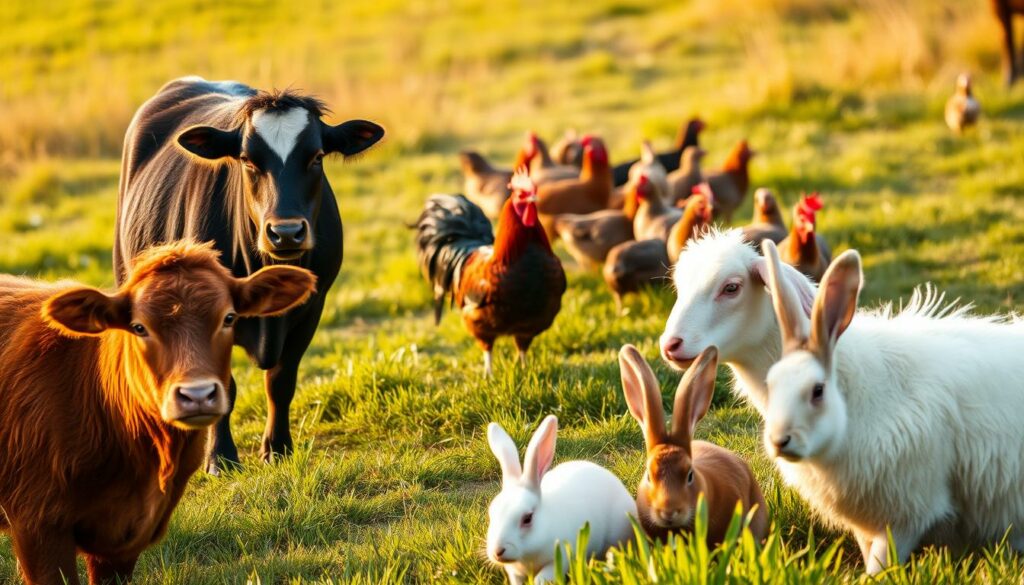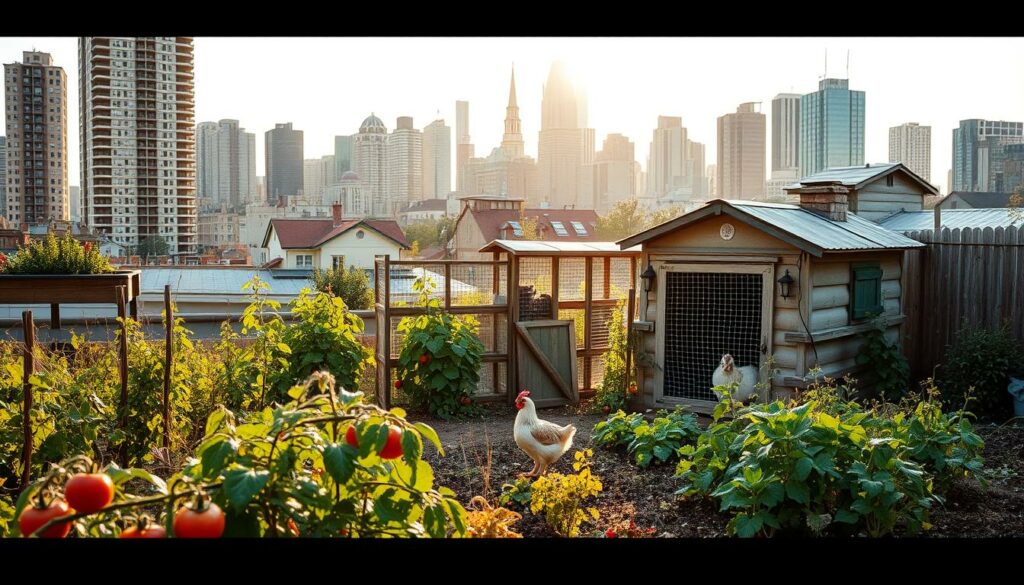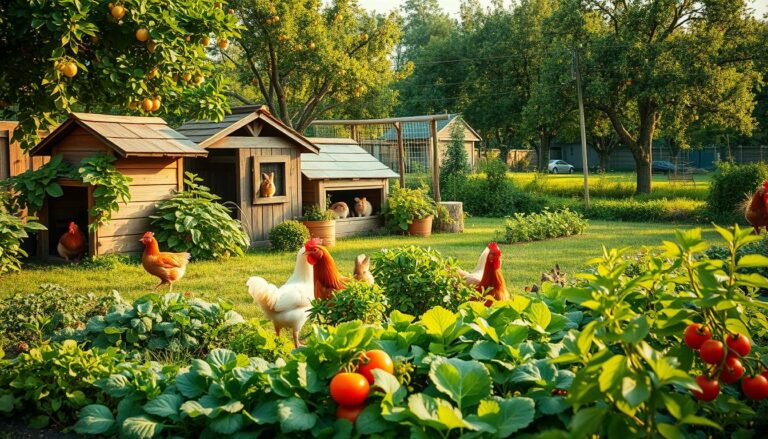Learn how a small homestead can bring big rewards by raising chickens and rabbits. This method boosts food security and supports sustainable living. David, an urban homesteader, shows how adding chickens and rabbits can increase your yield.
By doing this, your backyard can become a hub of productivity. It ensures a steady supply of meat and eggs. Plus, it helps your garden’s ecosystem.
Key Takeaways
- Integrating chickens and rabbits in your backyard farming can significantly enhance food security.
- Both animals provide sustainable protein sources, ideal for urban agriculture.
- Rabbits have a rapid reproduction cycle and can be processed for meat within 8-12 weeks.
- Chickens offer a reliable source of eggs and meat, contributing to a self-sufficient homestead.
- Using this model, you can ensure efficient use of space and resources for maximum productivity.
- Understanding the key benefits and requirements can help urban families make informed decisions about raising homestead livestock.
The Concept of Stacking Functions in Permaculture
Permaculture focuses on using every part of a system for more than one thing. This way, resources are used well and sustainability is boosted. It’s great for making gardens and farms in cities and suburbs work better.
Synergistic Benefits
Stacking functions make a homestead more productive and strong. For example, chickens do many things like give eggs, control pests, and make manure. They help the garden grow better and the soil stay healthy.
Another good example is silvopasture. It mixes trees and animals to use land better. Cattle eat under trees, getting shade and food, while trees grow timber and fruit. This shows how different parts of a system can work together well.
Real-life Examples
Joel Salatin’s Polyface Farm is a great example of stacking functions. Chickens follow cattle, helping control pests and fertilizing the soil. This makes the pasture healthier and increases egg production.
David uses chickens under rabbit cages in a ‘Raken House’. This setup manages waste and gives chickens more food. It’s a great example of how gardening can work together with animals.
The Permaculture Design Course (PDC) teaches people to make systems that do many things. It’s hands-on and teaches how to pick key species. These species, like apple trees, do many things like give food, feed animals, and help the environment.
- Provides food (eggs and meat).
- Generates manure for soil fertility.
- Assists in pest management.
- Serves as fodder for livestock.
- Provides mulch or fuel from pruned wood.
- Attracts pollinators during blooming.
Getting scholarships for these courses shows how education helps with sustainable living. It’s supported by donations to foundations like the Mastate Charitable Foundation.
| Element | Functions |
|---|---|
| Apple Tree |
|
| Chickens |
|
These examples show how permaculture, gardening, and farming together make a strong and green homestead.
Creating a Raken House: The Perfect Combination
Daniel Salatin’s Raken House design is a smart way to use space and resources. It combines rabbits and chickens in a vertical setup. This approach cuts down on waste and boosts productivity, following permaculture principles. Let’s look at how to build, what materials to use, and how to keep it running smoothly.
Building the Structure
Begin by planning a layout where rabbits are housed above chickens. This vertical setup makes the most of space. Use strong wood frames for the rabbit cages and add a roof to keep it dry.
Make sure the chickens have roosting posts and nesting boxes. This keeps them comfortable and productive.
Essential Materials
Choosing the right materials is key for a lasting Raken House. Here’s what you’ll need:
- Wood: For the frame and nesting boxes.
- Wire Mesh: Keeps rabbits in and air flowing.
- Roofing Materials: Keeps the rain out.
- Deep Litter Bedding: Absorbs rabbit urine and helps compost.
These materials make the housing framework strong and efficient.
Maintenance Tips
Keeping the Raken House clean and healthy is vital. Here are some tips:
- Use the deep litter method for easy cleaning and waste management.
- Check and clean waterers and feeders often. Hang chicken waterers high to avoid dirt.
- Ensure good ventilation and light to reduce odors, more so during rainy weeks.
- Change shallow bedding often, but deep bedding absorbs smells better.
Following these tips keeps the Raken House clean and productive. Data shows it can cut fly numbers and boost egg production by improving forage use.
The Raken House is a prime example of permaculture housing. It shows how to reduce waste and increase productivity effectively.
| Aspect | Key Statistic |
|---|---|
| Fly Population Reduction | Reduced to one-third of 2016 level |
| Egg Production Efficiency | Improved due to increased forage consumption |
| Odor Control | Significant reduction, more with deep bedding |
| Manure Management | Enhanced composting processes |
Advantages of Raising Chickens and Rabbits Together
Keeping chickens and rabbits together in one place has many benefits. It makes farming more efficient and better for both animals. This way, you use less space and resources, manage pests better, and increase farm productivity.
Odor Control
One big plus is controlling odors. Chickens help break down rabbit manure, making it less smelly. Their digging and pecking mix the manure well, keeping things tidy.
Fly and Rodent Management
Managing pests is another plus. Chickens keep flies away by disturbing the manure. They also eat all the feed, so there’s less for rodents.
Resource Efficiency
Chickens eating leftovers saves money on feed. This setup makes farming more efficient by using resources better and wasting less. It also helps the farm’s finances by cutting down on feed costs.
| Aspect | Benefit |
|---|---|
| Space Utilization | Shared enclosures save up to 50% of garden space |
| Odor Control | Enhanced composting reduces bad smells |
| Pest Management | Reduction in flies and rodents |
| Resource Efficiency | Reduced feed costs through shared leftovers |
Choosing the Right Animals for Your Homestead
Choosing the right animals for your homestead is key to getting the most meat and keeping practices green. Knowing the best breeds for your needs can really help you succeed. This guide will help you pick the best chickens and rabbits for meat and explain the differences between commercial and heritage breeds.
Best Chicken Breeds for Meat
The Jumbo Cornish Cross is top for meat production. They grow fast and have a lot of meat. For colder places, the Rhode Island Red is great. It’s tough and works well in many places.

Best Rabbit Breeds for Meat
For quick and good meat from rabbits, go for New Zealand and Californian breeds. They grow fast and have great meat. A healthy rabbit can have up to six litters a year, with each litter having 4 to 12 kits. This makes them a top choice for homesteaders.
Commercial vs Heritage Breeds
Choosing between commercial and heritage breeds depends on what you want. Commercial breeds like the Jumbo Cornish Cross grow fast, perfect for quick meat. Heritage breeds, like the Rhode Island Red, are better for the long run. They live longer and are more resistant to diseases.
| Breed Type | Growth Rate | Meat Quality | Longevity |
|---|---|---|---|
| Jumbo Cornish Cross (Commercial) | Fast | High | Short |
| Rhode Island Red (Heritage) | Moderate | Moderate | Long |
| New Zealand Rabbit | Fast | High | Moderate |
| Californian Rabbit | Fast | High | Moderate |
Choosing the right animals for your homestead needs thought. You want to get meat while keeping things sustainable and healthy. This ensures your homestead thrives.
Raising Backyard Livestock: A Sustainable Protein Source
Urban farming is becoming more popular, and families are starting to raise backyard livestock. They keep chickens and rabbits to get fresh eggs and meat. This way, they don’t have to rely on store-bought meat as much. It’s a great way to be self-sufficient and green, even with little space.
About 10.5 million U.S. homes have chickens for eggs. One hen can give 200 to 300 eggs a year. This shows how many people are choosing backyard poultry farming for a greener lifestyle. Plus, it can save families up to 60% on food costs.
Rabbits are another good choice for backyard farming. They grow fast and need little space. Chicken poop is also great for gardens, adding nutrients like nitrogen and potassium.
Keeping livestock at home can cut down on carbon emissions by 25%. This is good for the planet. Also, 23% of families sell their extra food at local markets. This helps build a stronger community around food.
In short, raising backyard livestock is a smart way to get protein and support local food systems. It’s easy to do and has many benefits. It’s perfect for families wanting to be more self-sufficient and green.
Cost Breakdown: Initial Setup and Maintenance
Starting a cost-effective farm with chickens and rabbits requires knowing the setup and maintenance costs. This guide helps you plan your budget. It ensures a good return on your livestock investment.
Cost of Raising Chickens
Starting a small chicken farm needs an initial investment in housing, equipment, and chicks. For a flock of 4 chickens, you’ll spend about $1,500 at first. This includes:
- Coop: Averaging $240 for a pre-built unit.
- Feeders and waterers: Approximately $30 for initial chick setup.
- Heating plate for brooders: $65.
- Bedding: $120 annually.
- Feed: $300 annually.
- Additional equipment: Auto-chicken coop doors ($300) and fencing ($300).
The annual maintenance cost is about $420, for feed and bedding.
Cost of Raising Rabbits
Raising rabbits also needs an initial investment, but it’s slightly lower than chickens. A basic setup costs around $600, including:
- Hutch and cage setup: $200.
- Feeding and watering systems: $50.
- Bedding: $100 annually.
- Feed: $250 annually.
Maintenance costs are manageable, averaging about $350 annually for feed and bedding.
Long-term Savings and Efficiency
In the long run, farming chickens and rabbits is very profitable. The initial investment in equipment and infrastructure pays off. They provide sustainable food sources, lowering grocery bills.
Raising chickens can save on egg purchases, with each hen laying up to 250 eggs annually. Rabbits also offer meat, a cost-effective protein source. By spreading costs over 2-4 years, you can see a big return on your investment through efficient use of resources and lower food costs.
| Item | Initial Cost | Annual Cost |
|---|---|---|
| Chicken Setup | $1,500 | $420 |
| Rabbit Setup | $600 | $350 |
| Feed & Bedding (Chickens) | – | $420 |
| Feed & Bedding (Rabbits) | – | $350 |
Health Benefits of Chicken and Rabbit Meat
Choosing healthy meals is key to a good diet. Chicken and rabbit meat are great choices because they’re full of nutrients but low in calories. Knowing their benefits helps us make better food choices.
Nutritional Comparison
Chicken and rabbit meat have their own nutritional perks. Rabbit meat has about 28 grams of protein per 100 grams and is low in cholesterol. This makes it perfect for those watching their cholesterol levels.
Chicken meat has around 24 grams of protein per 100 grams. The protein content varies based on the cut. Breast meat is usually leaner than thighs or drumsticks.
| Meat Type | Protein (per 100g) | Fat Content | Cholesterol Level |
|---|---|---|---|
| Rabbit | 28g | Low | Low |
| Chicken | 24g | Varying | Moderate |
| Quail | 20g | Higher | Moderate |
Dietary Advantages
Eating chicken and rabbit meat has many benefits. Rabbit meat is high in protein and low in fat, making it great for healthy eating. It’s also low in calories, which is good for weight management.
Rabbit meat is also efficient to produce, needing only 25 pounds of feed to make 6 pounds of meat. This makes it a sustainable choice.
Chicken is versatile and can be cooked in many ways. It has different fat levels, so you can choose leaner options like breasts or richer flavors from thighs and drumsticks. Adding both to your diet ensures you get all the nutrients you need without sacrificing taste or health goals.
Space and Environmental Considerations
Raising chickens and rabbits in cities and suburbs works well with the right approach. These animals need less space than bigger animals. Good management keeps the neighborhood quiet and boosts the benefits of *urban homesteading*.
Urban and Suburban Farming
Urban and suburban areas are great for *small space farming*. It needs careful planning but leads to sustainability and self-sufficiency. Adding livestock to *urban homesteading* spaces improves food security and balances ecosystems.

Space Requirements
Chickens and rabbits need less space. Knowing their needs is key. For example, a chicken needs 3-4 sq. ft. of housing and 10 sq. ft. for running around. Rabbits also do well in small spaces, perfect for city living. Use space wisely to meet your *small space farming* goals.
| Animal | Enclosed Housing | Exercise Yard | Pasture |
|---|---|---|---|
| Chicken | 3-4 sq. ft. | 10 sq. ft. | N/A |
| Rabbit | 3-4 sq. ft. | 10 sq. ft. | N/A |
Noise and Smell Management
Managing noise and smell is key for peace with neighbors and animal health. Using insulation and smart placement cuts down on noise. Regular waste management stops smells; manure should be aired out and not kept for over three weeks. Knowing the *environmental impact of livestock* helps avoid problems and makes *urban homesteading* successful.
Raising Chickens and Rabbits: Complementary Practices
Keeping chickens and rabbits together on a homestead is a smart move. It uses each animal’s strengths for a better system. This approach helps with pest control, waste, and soil health.
Why They Work Well Together
Chickens and rabbits are great friends in farming. Chickens help control pests by eating bugs. Rabbits make the soil better with their manure.
Challenges and Solutions
But, there are challenges to overcome. Chickens and rabbits need different food and space. It’s important to meet their needs for their health.
- Separate Feeding Areas: Make sure each animal has its own food spot. This stops them from fighting over food.
- Proper Spatial Design: Give them enough room. This helps reduce stress and fights. Separate places to sleep also helps.
- Hygiene Practices: Keep everything clean. This stops diseases from spreading. Cleanliness is key to keeping both healthy.
Table: Comparative Benefits and Challenges of Raising Chickens and Rabbits Together
| Chickens | Rabbits | |
|---|---|---|
| Pest Control | Reduces pest populations by up to 30% | N/A |
| Soil Fertility | Through manure scratching | Nitrogen-rich manure |
| Feeding Requirements | Grains, seeds, insects | Hay, fresh greens, pellets |
| Space Needs | More room needed for scratching | Compact living spaces |
| Health Management | Regular flock health checks | Weekly growth and health monitoring |
By using these farming methods, understanding each animal’s needs, and keeping things clean, you can have a thriving homestead.
Best Practices for Combining Chicken and Rabbit Farms
Combining chickens and rabbits on one farm needs careful planning. It’s important to meet each species’ unique needs. This way, resources are used well and animals stay healthy.
Feeding and Nutritional Needs
Chickens and rabbits have different diets for their health. Chickens eat grains, while rabbits need lots of fiber. Keeping their food separate stops health problems like rabbit GI stasis from chicken feed.
Introduce baby chicks to rabbits when they’re four to six weeks old. Baby rabbits can join at about four weeks. This staggered start helps avoid food fights and helps them get used to each other.
Health and Disease Management
Keeping animals healthy is key to avoiding diseases. Regular health checks and spaying/neutering reduce fights and territorial behavior in rabbits. Diseases like Fowl Cholera can hit both chickens and rabbits hard.
Rabbits need at least an hour of calm time with chickens before living together. This slow introduction helps them get along better.
Waste Management and Composting
Good waste management is key in permaculture. Manure from chickens and rabbits makes soil better. Rabbit poop and hay are great for compost, making gardens grow strong.
Using 2″ chicken wire keeps rabbits safe from predators. This also keeps their living area clean. Starting with separate spaces helps both species feel safe and respected.
| Aspect | Chickens | Rabbits |
|---|---|---|
| Feeding | Grain-based, supplemented with greens | High-fiber diet, grass supplements |
| Health Management | Regular check-ups for disease prevention | Spaying/neutering to reduce aggression |
| Waste Management | Manure enriches soil quality | Droppings used as fertilizer |
| Sustainable Practices | Soil enhancement through manure | Composting leftover hay and droppings |
Legal and Zoning Requirements
For urban or suburban homesteaders, knowing the law is key. It’s important to follow legal farming practices, homestead zoning laws, and regulatory compliance. This helps avoid legal trouble and supports ethical farming.
Understanding Local Laws
Local laws differ a lot. It’s important to know the rules in your area. Many cities now allow raising animals at home, as long as you follow certain rules.
Here are some important points:
- A minimum lot size is often based on the number of animal units (1,000 pounds of live weight).
- Fences for animals must be at least 48 inches high. You must also dispose of dead animals properly, to avoid disease risks.
Licensing and Permits
Getting the right licenses and permits is key to regulatory compliance. For urban homesteaders, meeting specific requirements is important. Here’s a look at common licenses and permits:
| License/Permit Type | Requirements | Purpose |
|---|---|---|
| Animal Husbandry Permit | Residential zones R1-R10, less than 8 animal units | Ensures proper housing and care |
| Manure Management Plan | Suggested for less than 8 animal units | Manure storage 100 feet away from state waters |
| Zoning Compliance Certification | Residential and commercial zones excluding C7 | Certify agricultural use compliance |
By following these rules and getting the right permits, your homestead can run smoothly. It will follow legal farming practices and homestead zoning laws. This avoids legal problems and supports sustainable farming in your community.
Getting Started: Practical Steps for Beginners
Starting a homestead with chickens and rabbits is both exciting and rewarding. First, you need to check how much space you have. Chickens need about 3 square feet indoors and 8-10 square feet outdoors, as the University of Missouri Extension suggests. Rabbits also need a lot of space, with hutches at least 24” by 36” for one rabbit.
It’s important to plan your budget for the start. Chickens can cost between $500 and $700, including coop and run setup, which starts at $300. Buying day-old chicks costs $3-5 each, while older chickens are more expensive. Rabbits are simpler but also need hutches, feeders, and bedding, adding to the cost.
Knowing how to care for animals is key for beginners. Chickens need daily egg collection, regular feeding, and coop upkeep. They produce about 1 cubic foot of manure every 6 months, so you’ll need to shovel often. Rabbits need constant food, water, and clean living spaces to do well. Getting help from local farmers and online resources can offer a lot of support and tips.
Following these steps will help you build a strong foundation for your backyard farm. Being well-informed and proactive makes starting a homestead a rewarding journey. The aim is to create a system that increases your food security and fits well in your urban or suburban area. Being prepared and connected with others will help you succeed in raising livestock for the first time.
FAQ
What are the benefits of raising chickens and rabbits together in a tiny homestead?
Raising chickens and rabbits together boosts food security. It provides a sustainable protein source. Plus, it makes the most of limited space.
This setup also manages waste and controls pests. It makes backyard farming more efficient.
How does the concept of stacking functions in permaculture apply to raising chickens and rabbits?
In permaculture, each element, like a chicken or rabbit, does multiple jobs. Chickens help manage waste by aerating and composting manure. Rabbits add fresh manure, enriching the soil.
This approach optimizes land use.
What is a Raken House, and how does it work?
A Raken House has chickens living under rabbit cages. Daniel Salatin created this design. It ensures chickens process rabbit waste efficiently.
This setup provides extra feed and creates a symbiotic environment.
What materials are essential for building a Raken House?
Building a Raken House needs durable wood, wire mesh, and roofing. Good ventilation and light are also key. They keep chickens and rabbits healthy.
How does raising chickens and rabbits together help with odor control?
Chickens aerate and compost manure onsite. This speeds up decomposition and cuts down on odor. It keeps the area clean and reduces bad smells.
What are the cost considerations for starting to raise chickens and rabbits?
Starting costs include housing and feeding for both. While it’s expensive at first, long-term savings are worth it. You save on food and reduce waste.
What are the health benefits of chicken and rabbit meat?
Chicken and rabbit meat are high in protein but low in fat. Rabbit meat is special because it’s high in protein and low in cholesterol. Both are healthier than red meats.
How much space is needed to raise chickens and rabbits in a backyard?
These animals need little space compared to other livestock. With smart design and management, even small areas can work for backyard farming.
What are the best breeds of chickens and rabbits for meat production?
For chickens, Jumbo Cornish Crosses grow fast and yield a lot of meat. For rabbits, New Zealand and Californian breeds grow quickly and have great meat quality.
What are the common challenges of raising chickens and rabbits together, and how can they be addressed?
Challenges include different diets and space issues. To solve these, design space carefully, feed them separately, and manage them well. This ensures both species do well together.
What legal and zoning requirements should be considered for backyard livestock farming?
Know your local zoning laws and get needed permits. This ensures you follow municipal rules. It avoids legal problems and promotes ethical farming.
Source Links
- https://homesteadingfamily.com/raising-rabbits-for-meat/
- https://rabbitsmarties.com/rabbits-vs-chickens
- https://ranchomastatal.com/blognewsletter/2016/8/15/the-art-of-stacking-functions
- https://permacultureplants.com/stacking-functions/
- https://theprepperjournal.com/2017/01/28/stacking-functions-increasing-yields-decreasing-labor-multi-function-elements/
- http://nwedible.com/combine-rabbits-chickens-homestead-raken-house/
- https://purgeandgrow.com/rabbit-hutch-or-chicken-coop
- https://blog.omlet.us/2020/05/06/want-to-keep-chickens-and-rabbits-together/
- https://homeandroost.co.uk/blogs/rabbits/rabbits-and-chickens?srsltid=AfmBOop-NjEdNu7k2-EBcNH1ocXajWXLb562pCNe8K8NWfgJtHTRkMPc
- https://www.eggshellonline.co.uk/can-rabbits-chickens-share-a-hutch?srsltid=AfmBOopb3PeR0L3wILqSVA3g5MZhfSsoQ4AnIIxQKVMIhd8x8-EwDQLt
- https://farmerboyag.com/blog/the-best-livestock-to-raise-on-a-homestead/
- https://www.grangecoop.com/grangeknows/starting-a-homestead-with-the-right-livestock/?srsltid=AfmBOor-ye8rVBSigpiT2Ns-76WtQiwAhqiCS2YrSnJOkQGPp0BxpS8z
- https://www.purinamills.com/chicken-feed/education/detail/five-reasons-you-need-more-backyard-animals
- https://extension.unh.edu/blog/2021/08/supporting-animals-sustaining-land-backyard-homestead-audio
- https://extension.okstate.edu/fact-sheets/simple-budgeting-and-pricing-calculations-for-backyard-hens.html
- https://www.spintheglobeproject.com/cost-to-raise-chickens/
- https://www.imperfectlyhappy.com/comparing-the-meat-quality-of-rabbits-chickens-and-quail-for-small-scale-farming/
- https://nomorestomachacres.com/raising-healthy-meat-for-your-family-in-a-backyard/
- https://www.happywifeacres.com/raising-rabbits-for-food/
- https://www.backyardherds.com/threads/housing-and-space-guidelines-for-livestock.14898/
- https://esc.rutgers.edu/fact_sheet/recommended-guidelines-for-domestic-livestock-in-residential-areas/
- https://ccesaratoga.org/resources/housing-and-space-guidelines-for-livestock
- https://backyardpoultry.iamcountryside.com/eggs-meat/the-emotional-gauntlet-of-raising-meat-chickens/
- https://attra.ncat.org/publication/small-scale-livestock-production/
- https://vetexplainspets.com/can-chickens-and-rabbits-live-together/
- https://homeandroost.co.uk/blogs/rabbits/rabbits-and-chickens?srsltid=AfmBOoru2UZuwh-VUSTqe3YIDQJQ_XF-LLwZp8s3J6gtf4Q6GIJOxq_U
- https://littleavalonfarm.com/raising-rabbits-for-meat-in-a-colony/
- https://permaculturepractice.com/integrating-animals-in-permaculture/
- https://njaes.rutgers.edu/e353/
- https://www.nyc.gov/site/agriculture/faqs/frequently-asked-questions.page
- https://www.almanac.com/raising-chickens-101-how-get-started
- https://www.fresheggsdaily.blog/2020/03/the-beginners-guide-to-raising-backyard.html

